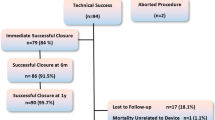Abstract
We herein report the advantages of retrograde ventricular septal defect (VSD) closure using a muscular VSD device for perimembranous VSDs. Perimembranous VSDs are conventionally closed by an antegrade technique (arteriovenous looping technique) using a patent ductus arteriosus or asymmetric perimembranous VSD device. However, we used a symmetrical muscular VSD device in all cases described in this report. Use of the antegrade technique for the first few patients with VSD resulted in prolonged procedural and fluoroscopic times and frequent slippage of the device into the right ventricle. Subsequent use of the retrograde technique shortened the procedural time and allowed for easier closure of the perimembranous VSD. We performed retrograde closure of perimembranous VSDs using a symmetrical muscular VSD device in 130 patients. We obtained a high rate of successful deployment (88.5 %) and a low rate of complications (6.0 %). We also achieved shorter procedural and fluoroscopic times than those associated with the antegrade technique.






Similar content being viewed by others
References
Bass JL, Karla GS, Arora R et al (2003) Initial human experience with the Amplatzer perimembranous ventricular septal occluder device. Catheter Cardiovasc Interv 58:238–245
Fu YC, Bass J, Amin Z et al (2006) Transcatheter closure of perimembranous ventricular septal defects using the new Amplatzer membranous VSD occluder. Results of the U.S. phase I trial. J Am Coll Cardiol 47:319–325
Gu X, Han YM, Titus JL et al (2000) Transcatheter closure of membranous ventricular septal defects with a new nitinol prosthesis in a natural swine model. Catheter Cardiovasc Interv 50:502–509
Hijazi ZM, Hakim F, Abu Haweleh A et al (2002) Catheter closure of perimembranous ventricular septal defects using new Amplatzer membranous VSD occluder: initial clinical experience. Catheter Cardiovasc Interv 56:508–515
Holzer R, de Giovanni J, Walsh KP et al (2006) Transcatheter closure of perimembranous ventricular septal defects using the Amplatzer membranous VSD occluder: immediate and midterm results of an international registry. Catheter Cardiovasc Interv 68:620–628
Kramoh E, Dahdah N, Fournier A et al (2008) Invasive measurements of atrioventricular conduction parameters prior to and following ventricular septal defect closure with the Amplatzer device. J Invasive Cardiol 20:212–216
Masura J, Gao W, Gavora P et al (2005) Percutaneous closure of perimembranous ventricular septal defects with the eccentric Amplatzer device: multicenter follow- up study. Pediatric Cardiol 26:216–219
Miro J, Hosking M, Lee KJ, et al (2005) Closure of perimembranous ventricular septal defects with the Amplatzer device: multicenter Canadian experience. Pediatric interventional cardiac symposium and emerging new technologies in congenital heart surgery (PICS/ENTICHS-2005), Buenos Aires, 15–18 September 2005
Pedra CAC, Pedra SRF, Esteves CA et al (2004) Percutaneous closure of perimembranous ventricular septal defects with the Amplatzer device: technical and morphological considerations. Catheter Cardiovasc Interv 61:403–410
Pinto RJ, Dalvi BV, Sharma S (2006) Transcatheter closure of perimembranous ventricular septal defects using Amplatzer asymmetric ventricular septal defect occluder: preliminary experience with 18-month follow up. Catheter Cardiovasc Interv 68:145–152
Rigby ML, Redington AN (1994) Primary transcatheter closure of perimembranous ventricular septal defects. Br Heart J 72:368–371
Thanopoulos BD, Rigby ML, Karanasios E et al (2007) Transcatheter closure of perimembranous ventricular septal defects in infants and children using the Amplatzer perimembranous ventricular septal defect occluder. Am J Cardiol 99:984–989
Yip WCL, Zimmerman F, Hijazi ZM (2005) Heart block and empirical therapy after transcatheter closure of perimembranous ventricular septal defect. Catheter Cardiovasc Interv 66:436–441
Author information
Authors and Affiliations
Corresponding author
Rights and permissions
About this article
Cite this article
Muthusamy, K. Retrograde Closure of Perimembranous Ventricular Septal Defect Using Muscular Ventricular Septal Occluder: A Single-Center Experience of a Novel Technique. Pediatr Cardiol 36, 106–110 (2015). https://doi.org/10.1007/s00246-014-0971-x
Received:
Accepted:
Published:
Issue Date:
DOI: https://doi.org/10.1007/s00246-014-0971-x




